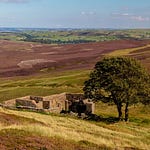The developers of the proposed Calderdale Energy Park have just released their scoping report — the first official step in the planning process for what could become one of England’s biggest onshore wind farms.
Their chosen site? Walshaw Moor — a protected blanket bog above Hebden Bridge. A place that stores carbon, regulates water flow, and plays a crucial role in protecting the Calder Valley from floods.
In our next episode, we sit down with Richard Lindsay, one of the UK’s leading peatland scientists as he responds to the scoping report’s approach to meeting the challenge of building on peat.
- He warns that infrastructure like roads and turbine foundations are never truly temporary — once you cut into peat, the damage is chronic.
- He explains why hydrological data from Walshaw Moor should be built into the Hebden Bridge Flood Alleviation Scheme — because changing the sponge on the hilltop could change flood risk in the valley.
- And he responds to Calder Valley MP Josh Fenton-Glynn, who recently told campaigners it can be acceptable to build turbines on protected peatland, based on evidence he says he has seen but cannot release.
This is more than a technical planning debate. It’s a clash between political assurances and scientific warnings, with consequences for climate targets, local democracy, and the safety of homes and businesses in the Calder Valley.
Make sure you are subscribed to Calderdale Inside Out to get the full story when it lands.








